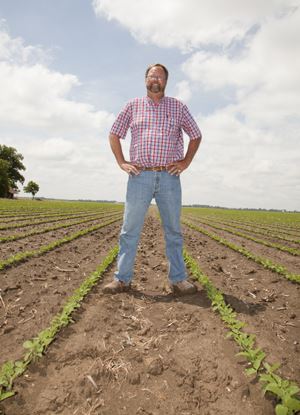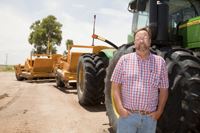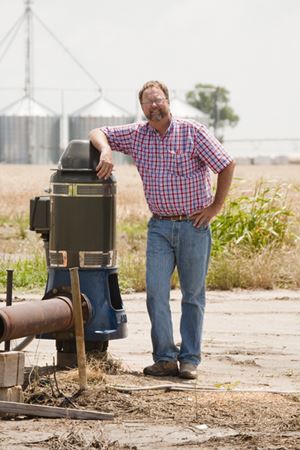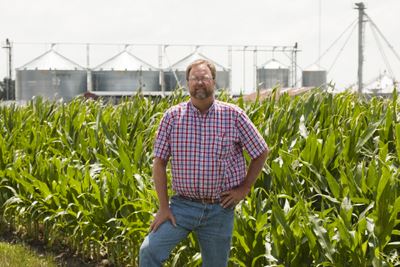|
Cheaper Is Not Better
Products That Do The Job Are Farmers’ Best Choices
BETTY VALLE GEGG-NAEGER
MidAmerica Farmer Grower
OSCEOLA, ARK.
Change is the best way to describe farming over the years, according to Ron Holthouse of Osceola, Ark. Years ago, a farmer saved seed raised in one year’s crop and cleaned it to plant the next year.
“Now with all our technology, we’re paying $60, $70 a unit, a 50- pound sack,” he said. “We’re putting everything on these beans to protect our investment. Years ago, we dumped a little bit of Captan Molly (captan methoxychlor) on and we were done. What’s caused all of this is the price of grain.”
Beans were selling for $6 a bushel but now have skyrocketed to $14- $15. Holthouse once used rebates and cheaper products. However, a test on a 40-acre field with a strip using Quadris, a strip using a cheaper product, and a strip with Priaxor fungicide, taught him that cheaper does not pay.
“They said the cheap product would save me $3 an acre, but when we combined the strips and downloaded the information we found the cheaper product cut 68, the Quadris cut 70, and the Priaxor fungicide cut 73.”
Holthouse began using BASF products about 5 years ago when the company asked him to go to the Carolinas for a buying deal.
“I was real impressed with BASF,” he said. “Usually we just bought the cheapest, but we looked at what they were doing with Headline fungicide up there and the seed treatments they used. We kept doing it our way here, but as I looked at the price of seed and how it changed, I was sold.”
When he first started farming a bag of cotton seed cost $45 and covered five acres. Today that bag of seed costs $550 and it still covers only five acres.
“Anything they can put on that seed to make it better, that’s what I have to do because of prices,” he said. “So now we’re using seed treatment and fungicide according to the need, and we’re cutting
70 bushels of beans and 80-90 bushels of wheat. We should have been doing this all along; the higher seed and market prices have pushed us to it.”
A test he did a few years ago with a fungicide on beans showed no yield difference across the entire field; however, Holthouse knows Priaxor fungicide is changing that.
“Priaxor might work every year whether the disease is there or not,” he surmised. “I really didn’t see a stage where the plants stayed greener. One didn’t combine any tougher than the other and that is a concern when you have 4,000 acres of beans to cut. You don’t want to slow the combine down because the beans are green and it’s grinding them out. We see that now in Liberty beans.”
He hasn’t used Liberty beans, but some of his friends have found it hard to combine. In a field of good wheat, he was cutting 13 acres an hour per combine, so three combines were cutting 39 acres.
“Some downed wheat the other day brought us back to 8 acres an hour, so we were only cutting 24 acres instead of 39,” he said. “In the heat of harvest where you need to get it out and plant beans back, it’s really a chore getting the crop out. We’re making the best wheat. One of the Travis Senter's fields showed 111 bushel average across the field. I never saw that in my entire life.
“Here in the south, we’re able to turn around and put in a bean crop,” he reasoned. “With the wheat market $6-$9 now, we could sell at $8. If you market some at $6.90, you’re making $7.50 a bushel, if you cut 100 bushels, that’s $750 an acre. Then you plant a bean crop and cut 50-60 bushels of beans at $13. You look at your total and it looks real good.”
With 3,300 acres of cotton this year, Holthouse finds the situation bleak. He cut his cotton acreage down from 4,800 acres last year.
Those 1,000 acres were sowed to wheat, and he feels the better cotton ground made the wheat lay down.
“I think the excess fertilizer that remained after the cotton just made it grow and flat outdo itself,” he said.
Holthouse has a family history of farming, as his father, R.B.
Holthouse, came to Manila, Ark., to farm a tract of land in his grandmother’s family.
He began a hog operation there, met his wife, Myrtle, at the Rusty Can Restaurant where she worked, married her and they had two daughters there at Manila.
About 1956 he wanted a bigger farm and he found a 500-acre farm in Osceola, so the family moved there where four sons completed the family.
“He always said the soil in Manila was sandy and easy to farm, and as soon as he moved to the rougher dirt, God realized he needed four boys. So I grew up on the farm in Osceola. That’s all I knew since I was 4 or 5. I was going to farm, no doubt in my mind.”
Of the four boys, he’s the only one that stuck with farming.
Holthouse himself has three children, two of whom are boys, with three of them partnering in the farm, Trey, Adam and Callie. Trey partners in the farm, although he has a sports management degree and is in charge of the Vanderbilt Stadium in Nashville.
Since the college Holthouse attended didn’t have an ag degree he studied business instead. College was work! He attended for three-and- a-half years and lacked 18 hours for a degree when he came home to farm. However his education helped him a lot in farming.
“Farming is not just putting something in the dirt, it’s keeping up with the money,” he said. “It’s a double-edged sword, you have to be good with a green thumb, but also good with money. That is what hurts so many young farmers today. The amount of money that’s needed when they start farming just overwhelms them. When I got my business courses I came home and started farming and never have looked back. A degree would be nice, but I don’t need it in farming.”
Soil in this area ranges from some of the best loam to black dirt. No two fields are the same. He has the best sharkey clay for soybeans and some of the best soil for cotton.
“I’m sitting in an area where farming is just a great thing. I don’t want all my eggs in one basket, I don’t want all my crop in beans, or in cotton. I was over 50 percent cotton last year and it wasn’t a cotton year price-wise so it hurt; it didn’t kill me, but if I had been hurting at the time I couldn’t imagine how it would have been.”
At one time his dad was farming 1,500 acres, but Holthouse has the perfect farm with 1,000 acres each of wheat, rice, cotton and beans, with 500 acres of corn coming into the mix a little later for a perfect blend.
“Now I’m double that,” he said. “My blends have not always made it the way I wanted, sometimes we’re a little heavier in rice, but we’re short on rice this year because of the weather. The blend I like would be about 40 percent cotton – unless it keeps going south, like it’s doing; then 25 percent each of rice and wheat. That leaves me about 10 percent early beans, then I’m rolling back in with beans after wheat, giving me about 35 percent beans. Then I throw a little bit of corn in there.
“I’m not a big corn man. Aflatoxin really scares me. We always have some aflatoxin problems here and we’re throwing everything but the kitchen sink at it; but it’s an eerie feeling knowing you can’t get rid of your corn after raising it. I had 650 aces of corn and it made
180 bushels and I couldn’t get rid of a bushel of it.”
His dad once did land leveling with an old Hancock buggy, then got away from it.
“When I got back from college after the drought of 1980, we decided we needed to get back into it,” Holthouse said. “In my lifetime, it was easy to make a crop in Osceola, we always got the rain. But 1980 was an awakening, and 1983, 1986 and 1989 were other awakenings. Two years we made a crop, then we had a drought.”
He added 110 acres of rice to the mix in 1980, overfertilizing at the start.
“It took us forever to cut, because it was flat on the ground; but that was the year of the drought and most were cutting 25-30 bushels.
We cut like 140-150 bushels that year, which was pretty good for those varieties back then. We put it in the bin and sold it for $7. So the next year we doubled our rice and never looked back since.”
Throughout his farming experience, when he finds he lacks the skills for some duties, Holthouse seeks out people who have those skills.




Photos by John LaRose, Jr.
That’s why he has computer guru, Travis Senter, on board to do computer work. Since he knew little about leveling, he also paired up with Scott Stockton.
“I was just dabbling with the land leveler, but he has been land leveling his whole life. He’s been with me ever since. I got my dad to buy a dirt pan, so now I have a dirt pan, Center Farms has a dirt pan, and Stockton has one.”
They level a third of each of their lands, and also do custom leveling. Overall this group is farming 18,000 acres, some of which is in Holthouse’s name, some in Stock’s name, then there’s 3,000 acres they farm together. They share the chores, so whoever can get to them first does so.
“It checks and balances,” Holthouse said. “What we’re seeing on the computer has been a big plus. Travis keeps track of all of it.
“He can download what the hi boys run, what the tractors run, fuel burning, everything,” Holthouse said. “We also do grid sampling.”
“I found out the big plus on grid sampling is the lime, the pH factor; in the past they would say ‘on a 40-acre field you need a ton.’ Grid sampling showed we need two tons on one part and none on the other. So if I put a ton across a field we were hurting on half of it. So on a five-acre field we’re putting the lime, the potash and phosphate where it’s needed. We started grid sampling on a third of the farm in 2009, a third in 2010, and the next third in 2011.”
The computer information is downloaded at Co-op who does the grid for them. Getting the fertilizer applied in time is quite a job, so they are considering buying their own truck.
“We’re using buggies now, but with our own rig we can get our nitrogen out more efficiently. With 18,000 acres we can keep it busy.
We’re to the size where bigger is not always better, but bigger helps if you want your own piece of land.”
Holthouse grades Roundup soybeans tops among the best tools for farming. “Bigger equipment is important, but not near what Roundup was to us,” he recalled. “It took no work, just spray it and it was gone. Then all of a sudden resistance set in and the greatest thing we ever had went south fast.”
Second on his list of best tools is a split between Liberty and big equipment. The big equipment adds efficiency to a day’s work. He places poly pipe next on the list.
“The ability to water a 40-acre field is next,” he said. “The poly pipe goes down, you drive over it, pop it back up and water it again. You have to put it down and pick it up and the cost of it is $200 to $300 on a piece of pipe every year.”
Irrigation sometimes occurs “whenever we get to it,” and sometimes it’s not even needed.
“We’re sitting on the greatest place in the world to raise crops.
Our water table is replenishing itself every year at five to six feet ground level. We have the most beautiful water supply in the world.”
The fields have not needed tiling. With 60-70 wells cased at 100 feet and pumps placed at 60 feet, farmers here have all the water they need.
Holthouse believes in going green. When a transformer blew and the power went out, he switched quickly from electricity to a diesel motor. Yet he prefers electricity for the efficiency and environment.
“Agriculture not only feeds the world, it also is the oxygen supply for the world,” he said. “All the factories put out the pollution, but agriculture really is pulling its weight. What growing corn, beans or cotton does for the environment is just unbelievable. We’re overly concerned in this county about the nitrogen runoff.”
Already he’s planning a rice field that recaptures the runoff and relifts it back to the field.
Chase Chafin, his nephew, is working with him on that. While there are seven in the operation, he and nephew, Chase, makes the day-to-day decisions. Chase lost his dad in an accident when he was 18 months old, so the only “dad” he has known was Uncle Ron. Chase joined Holthouse farms six years ago upon graduation from Arkansas State.
Without Roundup to decimate weeds, he’s learning new ways to curb marestail and pigweed. Since marestail is a winter weed, you could put the chemical out in February or March and that was it.
“Then all of a sudden Palmer pigweed popped up and it’s an annual,” he noted. “It comes up in March or April and it’s here all year. It’s been a nightmare. We went back to conventional, to plowing, we went back to chopping like I did as a kid. My farm manager was here earlier and he used Sharpton. We had a test plot of Sharpton, and he put Sharpton on a grown field we manage. He sprayed it, and that Sharpton wiped things out. It’s probably the greatest thing you ever saw.”
However, Holthouse is most grateful for Newpath from BASF.
“It has changed our rice,” he explained. “We were fixing to lose rice because of the red rice, then all of a sudden there was an alternative. Newpath is for BASF as Roundup was for Monsanto.”
“BASF plays more of a role in my rice right now,” he said. “It has been an amazing player. We were using Facet in every acre, then all of a sudden we were using Newpath. Clearfield came into play and I’ll shoot for 50/50 on grain. On half my acres we’ll use Newpath and half will be conventional and we’re putting Facet on it.”
With fungicides, he’s been a Quadris man for years then he decided he needed to switch. He used the cheapest on the wheat this year but is questioning that decision. One field check strip did not get Headline fungicide, but his scout said he should look at Tilt, Quilt, Stratego and Sharpton.
“I’ll probably have a lot of BASF this year, then buy a little Quadris, but I probably won’t put the cheap out at all,” he stated.
“Cheap is not always best. Even though you’re spending a huge amount of money, you have to do it. It’s overwhelming the money it takes.”
To the farmer who’s thinking of using Priaxor fungicide, he has some advice:
“If you don’t try it I think you’re really missing a good product. I tried it and I’m not going to say I’m going to do 100 percent of it this year, but I’m probably going to have it on 40-50 percent of my crops.”
“I’m spending $7 million a year farming. I spend more in two weeks at the peak time of the year than my dad spent the whole year when I was a kid,” he recalls.
He’s also trading volume deals with John Deere, spending $6-$7 million. “That’s what my new equipment costs, but I’m giving them my old one. I use a tractor all year and trade for $6,000. We ran the header and combine both for $67,000, but we cut a lot of grain too.
What that does is give us the per cost of harvesting. I can trade for around $65,000 on the combine and I run this many million bushels through it and I know my cost is 5-6 cents bushel.”
Holthouse refutes any notion that farmers are harming the land.
“That’s not what we’re doing at all. Your land is like your kid, you have to feed it well, take care of it, and we’re doing the same thing with our land. It has to pass to the next generation. We’re just trying to make what we have better for the next generation in order to keep pace with the world. We’re doing a good job.”∆
BETTY VALLE GEGG-NAEGER: Senior Staff Writer, MidAmerica Farmer Grower
|
|